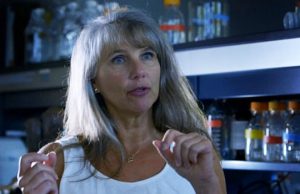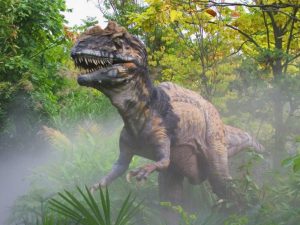
Abaddon
 26. 04. 2024
26. 04. 2024



 02. 03. 2024
02. 03. 2024

When Mary Schweitzer, a paleontologist at the University of North Carolina, discovered their soft tissues in dinosaur fossils, the question arose before the current doctrine of ancient creatures if we could ever find the original dinosaur DNA. And if so, we can use it to recreate this strange animals?
Finding clear answers to these questions is not easy at all. Dr. Schweitzer agreed to talk to us about what we know about dinosaur genetic material today and what we can expect in the future.
Is it possible to get DNA from fossils?
The question should rightly be: "is it even possible to obtain dinosaur DNA"? Bones are made up of the mineral hydroxyapatite, which is very similar to DNA and other proteins. In laboratories today, this knowledge is used to determine them. Dinosaur bones have been in the earth for 65 million years, and it is very likely that if we start looking for DNA molecules in them, we have a chance to find them. This is because some biomolecules can attach to this mineral (as if to stick).
So the problem is not to find DNA in the bones, but to prove that it is really a dinosaur molecule and not DNA that comes from other possible sources.
Will we ever be able to reassemble the original DNA from dinosaur bones? The scientific answer is yes. Everything is possible until proven otherwise. Can we now prove the impossibility of isolating dinosaur DNA? No, we can't. Do we already have the original molecule with dinosaur genes available? We don't have it yet.
How long can DNA be preserved, how can it prove that it belongs to a dinosaur and did not get into the sample in the laboratory together with some impurities?
Many scientists believe that DNA can only be preserved for a relatively short time. They believe that molecules can last intact, at best, a million years and certainly not 5-6 million years. Such a view gives us hope to see the DNA of creatures living more than 65 million years ago. But where did these numbers come from?
The researchers who studied this assay inserted DNA molecules into hot acid and measured the decay time of the molecules. High temperature and acidity were used to simulate the long-term effects of various factors. According to the results of these tests, the disintegration occurs relatively quickly.
Using one such test, which compared the number of molecules successfully extracted from samples of different ages (from several hundred to 8000 years), they concluded that the older the sample, the lower the number of molecules obtained.
A decay rate model was also developed and scientists predicted, although they did not test their claim, that the finding of DNA in Cretaceous bones is highly unlikely. Surprisingly, the same research has shown that old age as such cannot explain the breakdown or preservation of DNA.
 On the other hand, we have four independent lines of evidence that molecules chemically similar to DNA may be localized in the cells of our bones, and thus we can assume the same for findings in the bones of dinosaurs.
On the other hand, we have four independent lines of evidence that molecules chemically similar to DNA may be localized in the cells of our bones, and thus we can assume the same for findings in the bones of dinosaurs.
So, we extracted DNA from dinosaur bones, how do we make sure it's not part of later contamination?
The truth is that the idea of retaining DNA for such a long time has little chance of success. Therefore, every finding of allegedly true DNA of dinosaurs must be subject to very strict criteria.
We propose the following:
Dinosaur DNA isolated from their bones should therefore be more similar to the genetic material of birds than crocodiles. And it differs from both and others. At the same time, it should be different from any DNA from the present.
If DNA tyrannosaurus consists of long strings that can be relatively easy to decode, we seem to be dealing with pollution and it is not a real DNA dinosaur.
At the same time, it is necessary to monitor the connection with birds and crocodiles in these more stable molecules. In addition, we can find lipids in fossils that are part of the cell membrane. Lipids are more stable than proteins or DNA molecules.
In the course of our research, we succeeded in localizing a substance, chemically similar to DNA, inside the bone cells of a tyrannosaur. We used both DNA sequencing methods and antibody and protein reactions that are typical of vertebrate DNA.
Will it then be possible to clone the dinosaur?
In a sense, yes. In the laboratory, cloning is commonly performed by inserting a known portion of DNA into a bacterial plasmid.
This fragment is replicated at each cell division and thus many copies of identical DNA are generated.
The second method of cloning consists in inserting the entire DNA set into a viable cell from which its core has been removed beforehand. This cell is then placed in the body and the donor cell begins  control the process of offspring development that will be fully identical to the donor.
control the process of offspring development that will be fully identical to the donor.
The famous sheep Dolly is just an example of the second method of cloning. When people imagine the cloning of a dinosaur, they usually mean something similar. However, this process is unimaginably complicated, and although it is not a scientific assumption, the likelihood that we will ever be able to overcome all the differences between dinosaur bone DNA and current animals to give birth to viable offspring is so small that I classify it. to the "impossible" category.
The fact that the probability of creating a real "Jurassic Park" is slim does not mean that it is not possible to create the original DNA of a dinosaur or other molecules from ancient remains. In fact, these molecules could still tell us a lot. After all, all developmental changes take place first in genes and are reflected in DNA molecules.
Reconstruction of molecules from specimens of dinosaur fossils can tell us something about the origination and expansion of various developmental changes such as feathering.
We also have the opportunity to obtain a lot of information about the lifetime of molecules in natural conditions directly, and not in the laboratory through experiments.
We still have a lot to learn in the analysis of fossil molecules, it is necessary to proceed with the utmost caution and verify the data we obtain. From the preserved molecules in fossils we can learn so much more interesting that it definitely deserves further research.